Denture adhesives (also called adherent or simply glue) come in powder, paste, or cream form which are used to improve the stability and retention of dentures. They fix and tighten the dentures in place, preventing any movements and dislodgment of the dentures on the bone ridge or the surface of your gums. There will not be any slippage during speaking or chewing, so it increases your functional abilities to an optimal level.
How does denture adhesive work?
Denture adhesive is applied undersurface of the dentures and on your soft tissues like gum and alveolar ridge. One great feature of denture adhesives is being soluble. When the denture adhesive gets wet, under the pressures of dentures, it flows and becomes inflamed. This makes the contact a tight one that works well against the pressures of dentures on your gums.

As it is hydrated, denture adhesives will seal the gaps between the gums and the dentures, which wouldn’t allow food particles to be trapped. In the moisturized environment of your mouth, adhesives will become more hydrated and will increase the sticky and adherence characteristics. You will benefit from a well-fitting and stable denture when your removable dentures sometimes have become uncomfortable or loose.
Bear in mind that denture adhesive can be used when your dentures need a little more security in place not for unsized, ill-fitting dentures that require readjustment, repair, or even replacement by the dentist or your prosthodontist. With denture adhesives, no matter what you are wearing in your mouth, partial denture or complete denture, you will definitely speak, eat, and make social contacts more comfortably.
The benefits of denture adhesives
- Improved stability and retention
- Denture adhesives will provide a stable and fixed condition for any removable dentures that are ill-fitting in your mouth or well-fitted dentures that need a little more security.
- Longer hold
- They have the advantage of holding dentures fixed for a longer time.
- Being soluble
- It means excellent bond and flowing under dentures unlike other products that stack up on just one spot and thicken.
- Comfortable eating and improved chewing
- You will not have any worries that food will go between the dentures and your gum because the adhesive seals the gap.
- No damages to your soft tissues
- Adhesives will spread well under the dentures, so no sore gums and oral soft tissue irritations occur.
- No fears while speaking
- Speak comfortably and laugh in parties or in front of large groups of people because the adhesive has glued the dentures tightly in your mouth.
Are denture adhesives safe?
Denture adhesive is nontoxic and compatible with oral contact with no major health risks if used in recommended amount. However, if you overuse the normal application, you may put your health at risk. Remember to use zinc-free denture adhesives. There are reports according to what both FDA and American College of Prosthodontists (ACP) state about the dangerous side effects of denture adhesives containing zinc.
Adhesives containing zinc if used over a long period, will cause neurotoxicity, nerve damage, numbing, tingling feelings, and more serious health problems, so you should avoid using denture adhesives that have zinc as part of the ingredients. Zinc exists naturally in foods and mineral supplements that we eat, so excess zinc in your body will cause several other health concerns including nausea, diarrhea, vomiting, and eating disorders.
As a precaution, ask a dentist about the safety of your denture adhesive and pay attention to the zinc-free properties before buying any.
You may need denture adhesive:
- When you have well-sized dentures but you want more stability and good retention
- When there is not enough natural sticky gums and soft tissues due to oral problems like lack of good saliva or xerostomia, which causes dry mouth and decreased retention and stability
- During adaptation or adjustment period. In the early days of denture-wearing times, you may find it difficult to get used to your dentures, so denture glue can make you feel comfortable with nicely fit dentures in your mouth.
- When you have undergone oral surgery or radiation therapy, which may have caused a lack of retention due to injuries, side effects, or healing periods
- In case of diseases and conditions related to salivary glands, dry mouth, and systemic diseases
- Those individuals that take medications regularly and may experience dry mouth. Certain medications will have side effects that can create problems with adhesion of their dentures.
- You have higher social contacts publicly and require a firm denture to improve your speaking and want better functionality from your dentures

You shouldn’t use denture adhesives if
- Dentures are inappropriate in size or ill-fitting in your mouth over a long period
- You don’t follow routine oral hygiene and practice denture care
- There are open cuts or wounds in your gums and oral soft tissues
- You happen to experience allergies with adhesive use
How to use denture adhesive
Follow the instructions for denture adhesive application and the most important guidelines for adhesive use. To achieve strong retention and stability as well as getting the most expected results, you should be aware of where and how to apply the paste, cream, or powder adhesives on your dentures.
- Step 1:
Clean the denture surface and make sure that the interior surface, where you should apply the adhesive, is as clean as possible.
- Step 2:
In case of using cream, paste, or strip, be sure that the inner surface should be dry. If you are using powder adhesive, wet the interior surface of your dentures.
- Step 3:
Prepare the appropriate amount to apply. If you are using cream or pastes, use 3 to 4 pea-sized or dots of strips in each top or bottom denture. Do not fill the entire undersurface with adhesive. Follow the label instructions for the necessary amount.
Remember not to use too much adhesives since it will cause oozing the adhesive out to the edges and under the denture once they are inserted in your mouth - Step 4:
Apply the denture adhesive. For creams or pastes, try to spread out the adhesive evenly to make a thin layer of adhesive under the surface of your dentures.
Use your clean and dry finger to do the distribution of the cream. But if you are using powder form, sprinkle the adhesive to the entire undersurface and shake off to distribute the powder as evenly as possible. - Step 5:
Immerse your dentures in cold water for around 30 seconds. This is to wet the glue completely on the dentures, which makes an excellent bond when dentures are seated on your gum.
- Step 6:
Place the dentures in your mouth and put pressure on them for a few seconds. If any excessive adhesive oozes out, trim away the extra adhesive.
- An important tip:
Avoid eating or drinking hot foods and drinks immediately after placement of dentures for around 15 minutes to allow a strong bond.
Frequently asked questions
This special glue can compensate for your unstable and unfit dentures depending on your necessity. Dry mouth is one such common situation that is associated with numerous background diseases and conditions. When there is not enough saliva or high-quality saliva in your mouth, you should expect that dentures will lose the stability that was expected from natural healthy gums and oral soft tissues.
Try to remake or have your dentures repaired if the dentures you are wearing aren’t your size anymore and are poorly ill-fitting. A well-sized denture that fits well in your mouth do not need adhesives all the time. You should bear in mind that denture adhesives demand cleaning off from your gums and the denture before each new application. Try to be patient and do your regular oral and denture hygiene care.
Dentures should be removed overnight to keep up with oral health issues and denture care. So, you may ask how I am going to remove them when I have used denture glue. Adhesives are supposed to hold your dentures in place during the whole day. Therefore, you should use some techniques to get the denture off your gums.
The first technique is to rinse your mouth with warm water for a few minutes to make the dislodgment easier. Then gently brush around the dentures to displace them. You can gargle with a mouthwash or even brush your soft tissues with toothpaste to facilitate the removal. Another way is to puff out your cheeks with air and then by holding upward or downward the flanges of your dentures, you knock them out of its position.
